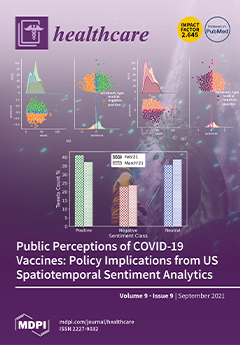Background: Measuring the fraction of inspired oxygen (FiO
2) is challenging in spontaneously breathing patients with impaired respiratory mechanics during low-flow nasal cannula. Our study investigates the FiO
2 with varied tidal volume (V
T) and respiratory rate (RR) among different
[...] Read more.
Background: Measuring the fraction of inspired oxygen (FiO
2) is challenging in spontaneously breathing patients with impaired respiratory mechanics during low-flow nasal cannula. Our study investigates the FiO
2 with varied tidal volume (V
T) and respiratory rate (RR) among different lung mechanics and provides equations to estimate the FiO
2. Methods: Two training and test lungs were used in this study, and the three lung mechanics (normal (R5/C60), restrictive (R20/C80), obstructive (R5/C40)) were designed. Spontaneous breathing with V
T (300, 500, and 700 mL) and RR (10, 20, and 30 breaths/min) was simulated. The flow rate of the nasal cannula was set to 1, 3, and 5 L per minute (LPM), and the FiO
2 was measured at the carina. Results: The lowest and highest FiO
2 were evident during high (700 mL) and low V
T (300 mL), respectively, among normal, restrictive, and obstructive lung models. As RR increases, this decreases the FiO
2. However, we found that V
T and oxygen flow rate are the principal factors influencing measured FiO
2 by multiple linear regression analysis. Conclusions: Our data suggest that the actual FiO
2 is never as high in spontaneously breathing patients as that estimated. V
T and oxygen flow rate had a substantial impact on the FiO
2.
Full article






